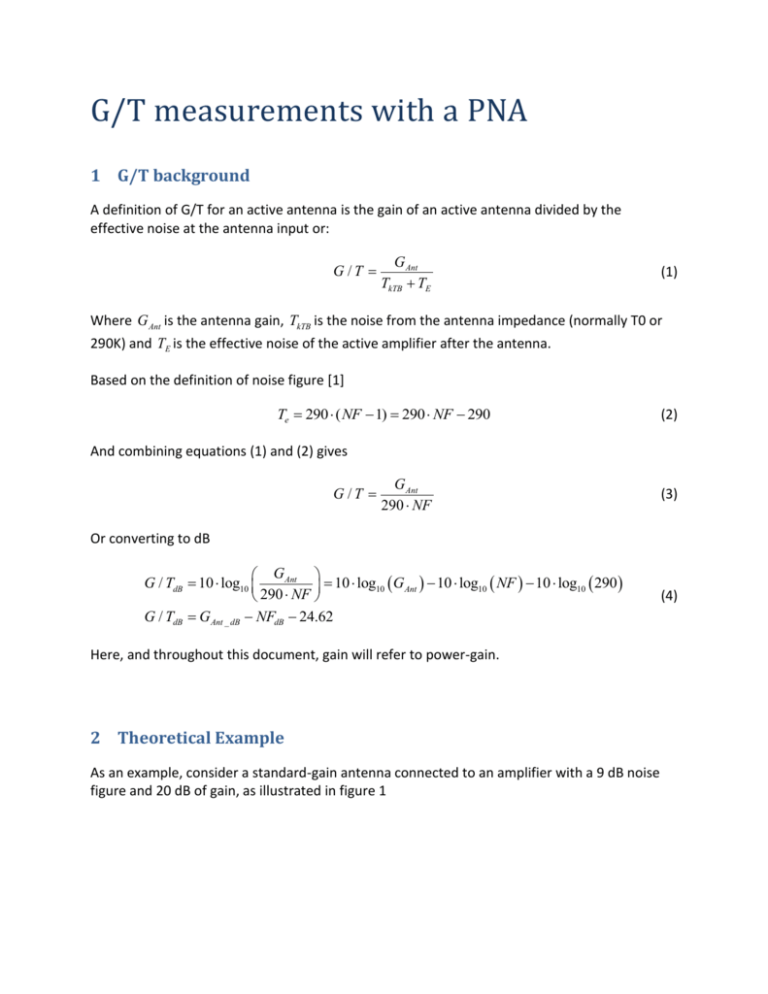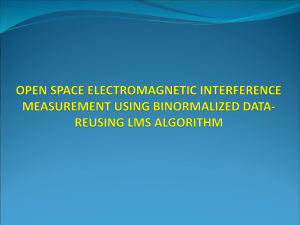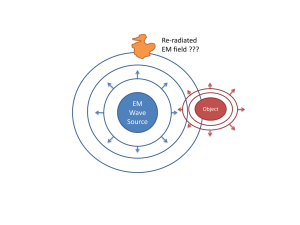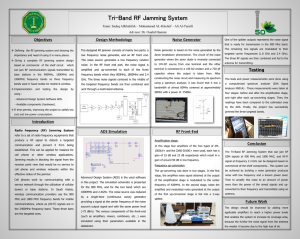GoverT
advertisement

G/T measurements with a PNA 1 G/T background A definition of G/T for an active antenna is the gain of an active antenna divided by the effective noise at the antenna input or: G /T G Ant TkTB TE (1) Where G Ant is the antenna gain, TkTB is the noise from the antenna impedance (normally T0 or 290K) and TE is the effective noise of the active amplifier after the antenna. Based on the definition of noise figure [1] Te 290 ( NF 1) 290 NF 290 (2) And combining equations (1) and (2) gives G /T G Ant 290 NF (3) Or converting to dB GAnt G / TdB 10 log10 10 log10 GAnt 10 log10 NF 10 log10 290 290 NF G / TdB GAnt _ dB NFdB 24.62 Here, and throughout this document, gain will refer to power-gain. 2 Theoretical Example As an example, consider a standard-gain antenna connected to an amplifier with a 9 dB noise figure and 20 dB of gain, as illustrated in figure 1 (4) Gain Horn Amplifier Excess Noise = DUTRNPI=29 dB G=20 G=24.7 dB NF=9 dB Figure 1: Reference DUT built from a standard gain horn and amplifier The G/T for this device can be computed as: NFAmp 10(9/10) 7.943 G Ant 10(24.7/10) 295.12 10 log10 (290) 24.62 dB G /T 295.12 0.128 290 7.942 (5) G / TdB 10 log10 G / T 10 log10 0.128 8.92 dB G / TdB G Ant _ dB NFdB 24.62 (24.7 9 24.62) 8.92 Thus, if one knows the gain of the antenna and the noise figure of the constituent amplifier, then the overall G/T can be simply computed by the dB values. Further, in this calculation, the gain of the amplifier does not affect the G/T value. However, this is a theoretical example, and in general the antenna cannot be separated from the amplifier in a real-world Device-UnderTest (DUT), so an alternative method is needed, in which the DUT is measured in an antenna range, and the range is compensated to account for the range loss, and loss from the measurement equipment to the range, which can be found in both the cable to the sourcing and antenna, and the cable from the DUT to the noise receiver. 3 Antenna Range Example and finding G/T Consider the same sample DUT measured in an antenna range, as shown in Figure 2. Here, the DUT is stimulated with a signal from the VNA and the overall gain and noise figure of the system is measured. For the moment, don’t consider the loss of the cables but presume the system is calibrated at the cable ends. VNA with built in NF capabiltiy TX Horn AirLoss=-75 dB NF=9 dB G=20 G=24.7 dB GTx=24.7 dB Excess Noise = DUTRNPI=29 dB G/T=-8.92 dB Figure 2: Antenna Range measurement for G/T In this example, over-the-air loss of 75 dB is assumed, and the range loss is reduced by the gain of the TX horn, GTx, causes the overall S21 of the system, and the noise figure of the system, to degrade by the same amount. In this case the range loss is computed as RL GTx AirLoss RL 10( GTxdB /10) 10( AirLossdB /10) 10(24.7/10) 10( 75/10) RL 295.12 31.62 109 9.3325 10 6 (6) RLdB 10 log10 ( RL) 10 log10 (9.3325 10 6 ) 50.3dB RLdB GTxdB AirLossdB 24.7 ( 75) 50.3dB (Note here that while the term for the AirLoss might imply a positive number, all gains and losses are expressed linearly as gains and thus a loss of 75 dB is expressed as -75 dB to ensure consistency in math operations. This is consistent with well-defined use, see [2] ) But in general this range loss is not known, so must be characterized in a separate measurement using a reference antenna such as a standard gain horn. Figure 3 shows the measurement of the range loss using the standard gain horn as a receiver. Here the range loss can be determined from the gain (S21) measurement of the overall range, and knowledge of the gain of the receiver standard-gain antenna: S 21RL RL G _ std 2 RL S 21RL / G _ std 2 10 RL ( 25.6/20) 2 2.754 103 9.331 106 (24.7/10) 10 295.12 RLdB 10 log10 9.331 106 50.3dB (7) RLdB S 21RL _ dB G _ std dB 25.6 24.7 50.3dB Here note that up to this point, all gains are expressed as power gains. To be consistent, the measured power gain in Figure 3 is found from (S21)2. VNA with built in NF capabiltiy TX Horn Gain Horn AirLoss=-75 dB GTx=24.7 dB G_std=24.7 dB Measured S21 = -25.6 dB Figure 3: Measurement of the Range Loss Now consider the effect of the range measurement on both the S21 of the overall system and the NF of the overall system. From first principles, the apparent noise figure of the DUT will improve by the antenna gain in the DUT (Gant), and degrade by the range loss. Thus the measured noise figure in this case will be NFSys NFAmp G Ant RL NFAmp G _ std G Ant ( S 21) 2 NFSys _ dB NFAmp _ dB RLdB G Ant _ dB NFSys _ dB 9dB ( 50.3dB ) 24.7dB 34.6dB NFSys _ dB NFAmp _ dB S 21dB G Ant _ dB G _ std dB NFSys _ dB 9 ( 25.6) 24.7dB 24.7dB 34.6dB (8) The first line of equation(8) might seem a little strange, as it is well known that loss (such as range loss) increases (or multiplies) the noise figure, where here the noise figure is divided by the range loss (that is subtracted in dB). Again, consistency in applying the linear math requires loss to be expressed in negative dB, thus to have loss before an amplifier –increase- the noise figure, the loss (a negative number in dB) must be subtracted from the noise figure. Likewise, the gain (a positive number dB) is also subtracted from the dB value of noise figure, or placed in the denominator for linear computations. Note that the system noise figure is the inferred noise figure of the embedded amplifier in the DUT, plus the overall loss of the combination of the antenna range and the embedded gain of the DUT antenna. Finally, combining equations (8) and (3) we can find the G/T as GAnt ( S 21RL )2 1 G _ std G /T NF 290 ( S 21 ) 2 NF G _ std Sys RL Amp G / TdB G _ std dB NFSys _ dB S 21RL _ dB 24.62 G _ std GAnt 290 ( S 21RL ) 2 290. NFAmp (9) G / TdB 24.7 34.6 ( 25.6) 24.62 8.92 In practice, only the noise figure measurement changes with DUT; the range loss S21 measured value, the gain of the standard gain antenna for the range loss, and the -24.62 dB term associated with the log of 290 derived from is 10 log10 (T0 ) are all pre-measured constant values. If these are saved as traces on a PNA, then the equation editor applied to a noise figure parameter can be used to compute G/T directly as G / T (mag ( S 21G _ std ) mag ( S 21G _ std )) / (290 ( NFSys )mag ( S 21RL ) mag ( S 21RL )) (10) Note that in equation (10), it is presumed that the power gain of the antenna will be loaded in as an S21 file, in which case it must be squared to return to linear power gain. Also note that this equation will only be correct if the underlying measurement parameter is noise power or noise figure due to the fact that only for these noise parameters does the formatter in the PNA presume power gains rather than voltage gains. 4 Calibration (or what about the cables) From the formulation found in equations (6) and (8), one can see that the effect of port 1 cable loss will be to increase the range loss and increase the noise figure thus RLCP1 RL ( S 21CP1 ) 2 GTx AirLoss ( S 21CP1 ) 2 S 21RL _ CP1 S 21RL S 21CP1 NFCP1 NFSys (11) ( S 21CP1 ) 2 1 G _ std 1 2 NFCP1 290 ( S 21RL _ CP1 ) NFSys ( S 21CP1 ) 2 1 G _ std G / TCP1 G /T NFSys 290 ( S 21RL ) 2 G / TCP1 G _ std 290 ( S 21RL S 21CP1 ) 2 Here CP1 denotes Cable-Port1. Thus, equation (11) demonstrates that if the cable from port 1 is not de-embedded for either the range loss measurement or the noise figure measurement, then there is no effect on the measured value for G/T. However, inspection shows that the same cannot be said for the cable on port 2. In this case, adding a cable to port 2 will increase the range loss (more negative), but to the first order, it will not substantially change the noise figure (provided the excess noise from the DUT is much greater than the cable loss), thus the G/T value will change by the dB loss of the cable. Due to this effect, it is recommended that the cable on port 2 of the PNA be measured and deembedded from the noise figure measurement of the PNA. References: [1] Dunsmore, Joel, “Handbook of Microwave Component Measurements”, 2012, John-Wiley, Chichester, UK. Pp. 15-17 [2] Dunsmore, Joel, “Handbook of Microwave Component Measurements”, 2012, John-Wiley, Chichester, UK. Pg 10






